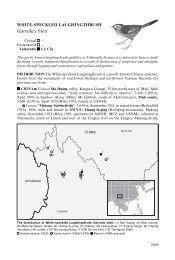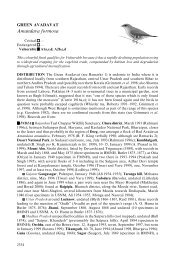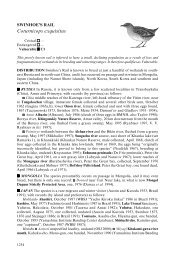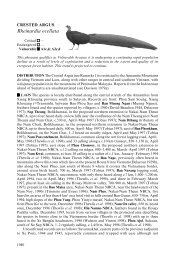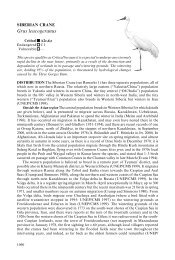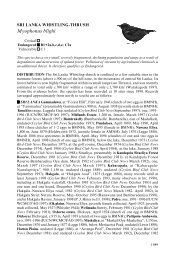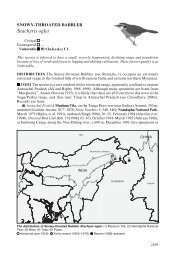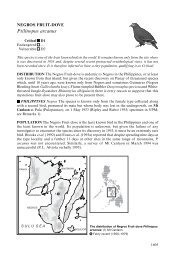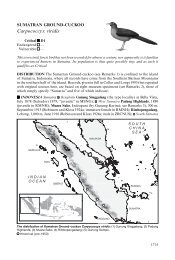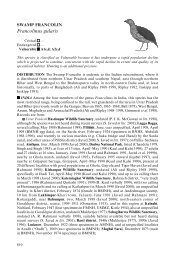Tadorna cristata - BirdBase
Tadorna cristata - BirdBase
Tadorna cristata - BirdBase
You also want an ePaper? Increase the reach of your titles
YUMPU automatically turns print PDFs into web optimized ePapers that Google loves.
CRESTED SHELDUCK<br />
<strong>Tadorna</strong> <strong>cristata</strong><br />
Critical D1<br />
Endangered —<br />
Vulnerable —<br />
There have been no confirmed records of this species since 1964, and it could be extinct. If it<br />
remains extant, the population must be tiny. It is classified as Critical because of recent<br />
unconfirmed reports that it survives.<br />
DISTRIBUTION The Crested Shelduck (see Remarks 1) is known by just a handful of<br />
confirmed records from south-east Russia, Korea and Japan, plus several unconfirmed reports<br />
from these countries and north-east China. On the basis of these records, which are mainly<br />
coastal and focused on the Korean Peninsula, Nowak (1984) proposed and mapped<br />
hypothetical breeding and wintering grounds for this species, suggesting that it might breed<br />
in forested mountains in far-eastern Russia (including southern Sakhalin Island), northern<br />
Korea and north-east China, and perhaps also on Hokkaido in Japan. His proposed breeding<br />
non-breeding range included parts of southern Japan, south-west Korea and the east China<br />
coast as far south as Shanghai. Several descriptions and contemporary drawings from the<br />
eighteenth and nineteenth centuries were described by Austin and Kuroda (1953), which<br />
suggest that this species was more numerous in the past and was imported frequently into<br />
Japan from Korea.<br />
■ RUSSIA The species is known by two records, both from near Vladivostok:<br />
■ Primorye near Vladivostok, female collected, April 1877 (Austin 1948, Austin and<br />
Kuroda 1953); Bol’shoy Pelis island (Rimski-Korsakov archipelago), one male and two females<br />
seen on an isolated rocky island north–west of Matveyer island, 16 May 1964, with a small<br />
flock of Harlequin Duck Histrionicus histrionicus (Labzyuk and Nazarov 1967, Labzyuk<br />
1972, hence Nowak 1983, Walmsley 1989), pair reported to have remained on a small lake in<br />
the Rimski-Korsakov archipelago from May–June 1964, the male being thought to be in full<br />
breeding plumage by 10 June (Walmsley 1989).<br />
■ JAPAN The species is known by a single nineteenth-century record from Hokkaido:<br />
Hokkaido Furubori, Ipponji, near Kameda-mura, Hakodate, pair collected and separate<br />
drawings made of the male and female, October 1822 (Kuroda 1940 in Austin 1948, Austin<br />
and Kuroda 1953).<br />
■ KOREA ■ NORTH KOREA There are two unconfirmed records: mouth of the Pochongang<br />
river (Pouchen river), North Hamgyong province, two males and four females seen on<br />
the sea, late March 1971 (O Myong Sok 1984, MKN and KUT 1987, Walmsley 1989; see<br />
Remarks 2); Yichuan, North Pyongan province, three reported shot from flock of six on the<br />
seashore, late March 1916 (Nowak 1983; also Walmsley 1989).<br />
■ SOUTH KOREA There were two confirmed records in the early twentieth century,<br />
and one unconfirmed report: ■ South Kyongsang lower reaches of the Nakdong river, near<br />
Pusan (Busan, Fusan), female collected (the type), December 1916 (N. Kuroda 1918, 1927,<br />
Austin 1948, Gore and Won 1971); ■ North Cholla Kum river mouth (Kun-Kiang), between<br />
Kiang king and Kun-san-fu (Gunsan, Gunzan), male and female collected, November or<br />
early December 1913 or 1914, on a muddy bar (Kuroda 1924, Austin 1948). An unconfirmed<br />
record was from North Chungchong (“Chushinhokudo”) province, two birds seen, possibly<br />
this species, March 1943 (Nowak 1983, Walmsley 1989; see Remarks 3).<br />
399
Threatened birds of Asia<br />
■ CHINA There have been several reports of this species from north-east China, but all are<br />
unconfirmed. A report from Yunnan was presumably erroneous (see Remarks 4). Most of<br />
these were the result of a five-year survey (1985–1990), during which leaflets with paintings<br />
of Crested Shelducks were widely distributed, and follow-up interviews were held with hunters<br />
and other outdoor workers who claimed to have seen this species (Zhao Zhengjie 1992; but<br />
see Remarks 5). Phillips (1922–1926) reported that G. D. Wilder of Peking University, in a<br />
letter to O. Bangs from China in 1921, said he thought he saw a specimen of this species in<br />
the hands of a Chinese hunter about 25 years before, when he had no idea of its rarity and<br />
the hunter did not wish to sell it. Other unconfirmed records are from:<br />
■ Heilongjiang unnamed forest river in the Da Hinggan Ling (Greater Xingan mountains),<br />
near the border of Heilongjiang and Inner Mongolia, where two were seen by an old forester<br />
and hunter (with 20 years experience), May 1987 (Zhao Zhengjie 1992, 1995); Da Hinggan<br />
Ling (Greater Xingan mountains), female seen by a taxidermist, April 1983 (Zhao Zhengjie<br />
1992; see Remarks 5);<br />
■ Jilin Dashitou Forestry Station, Changbai Shan mountains, four seen by a hunter,<br />
spring 1984 (Zhao Zhengjie 1992, 1995), two of which he shot and ate (Zhao Zhengjie 1992);<br />
Yalu Jiang river, Ji’an city, five seen by a “bird lover”, autumn 1984 (Zhao Zhengjie 1992,<br />
1995), and two seen by the same person at the same locality, April 1986 (Zhao Zhengjie<br />
1992; see Remarks 5); tributaries of the Tumen river, two seen by a hunter, spring 1986, in a<br />
river inside the forest (Zhao Zhengjie 1992, 1995); Naitou river, Changbai Shan mountains,<br />
“a duck very similar to Crested Shelduck” seen by an ornithologist (with 30 years experience),<br />
RUSSIA<br />
1<br />
CHINA<br />
2<br />
3<br />
NORTH KOREA<br />
S E A O F J A P A N<br />
5<br />
SOUTH KOREA<br />
JAPAN<br />
HONSHU<br />
4<br />
SHIKOKU<br />
The distribution of Crested Shelduck <strong>Tadorna</strong> <strong>cristata</strong>: (1) Vladivostok; (2) Bol’shoy Pelis island; (3) Kamedamura;<br />
(4) Nakdong river; (5) Kum river mouth.<br />
Historical (pre-1950) Fairly recent (1950–1979)<br />
400
<strong>Tadorna</strong> <strong>cristata</strong><br />
spring 1988, but it was too distant from him to be sure of the identification (Zhao Zhengjie<br />
1992; see Remarks 5);<br />
■ Liaoning Yalu Jiang river estuary, “on the sandy shore not far away from the estuary”,<br />
eight seen by an old hunter, October 1976 (Zhao Zhengjie 1992, 1995);<br />
■ Hebei Chengde (Jehol province), three birds believed to be this species collected, but<br />
the skins not preserved, 1936 (Nowak 1983, Walmsley 1989, Environment Agency of Japan<br />
1991); Fengtian Nan Yunhe, Liaoning, Hebei or Tianjin (see Remarks 6), three birds believed<br />
to be this species seen, and one collected, but the skin not preserved, May 1930 (Environment<br />
Agency of Japan 1991).<br />
POPULATION According to Uchida (1918), birds of this species “seem to have been”<br />
imported from Korea into Japan by bird dealers about two hundred years ago, indicating<br />
that at that time it may not have been as rare in Korea as at the start of the twentieth century<br />
(Kuroda 1918). However, Nowak (1983) suspected that the species has been rare for the past<br />
three hundred years. The recent records suggest that it may still survive, but almost certainly<br />
in very small numbers (see Distribution). Zhao Zhengjie (1992) suggested that a population<br />
of not more than 50 birds could still exist on mountain streams in the Changbai Shan<br />
mountains and Da Hinggan Ling (Greater Xingan mountains) (the latter also regarded as a<br />
possible area by Nowak 1983).<br />
ECOLOGY Habitat The Crested Shelduck has mainly been recorded in pairs or small flocks<br />
in coastal localities, often near the mouth of a river, with several unconfirmed reports from<br />
inland localities in north-east China (see Distribution). It has been recorded on the sea with a<br />
flock of Harlequin Duck near an offshore island (see Distribution), on the sea, 40–50 m offshore<br />
(O Myong Sok 1984, MKN and KUT 1987; but see Remarks 2), and on a muddy bar (Kuroda<br />
1924, Austin 1948). Several of the recent unconfirmed records in China were of birds on forest<br />
rivers, with one from a “sandy shore not far away from an estuary” (Zhao Zhengjie 1992).<br />
E. Nowak (verbally 1988) suggested that it is a boreal species which nests at c.1,700 m at the<br />
treeline, perhaps away from water or on volcanic lakes.<br />
Food The species may well feed at night; the bill structure suggests that the bird may not<br />
filter water for animal food, but subsist on grass and other vegetable matter (Nowak 1983).<br />
Breeding The species is judged to nest in tree-holes, although the use of littoral zones of<br />
lagoons and coastlines cannot be excluded (Nowak 1983). It is judged reasonable to assume<br />
that the clutch size does not exceed 10, and that only the female incubates; the anticipated<br />
season is May–July (Nowak 1983).<br />
Migration On migration the species appears to form small flocks (Nowak 1983).<br />
Hypothetical breeding and wintering grounds have been proposed and mapped for this species,<br />
with the inference that it migrates between these two regions (Nowak 1984; see Distribution).<br />
THREATS No explanation has been advanced for the decline of this species. However, if it<br />
still survives in the wild, its numbers are likely to be so low that an accident could lead to its<br />
extinction. Industrial and urban development, and human disturbance, on the coast of North-<br />
East Asia pose a potential threat (see Threats sections for, e.g., Chinese Egret Egretta<br />
eulophotes, Black-faced Spoonbill Platalea minor, Steller’s Sea-eagle Haliaeetus pelagicus,<br />
Spotted Greenshank Tringa guttifer and Saunders’s Gull Larus saundersi).<br />
MEASURES TAKEN The Crested Shelduck is a protected species (category 1) in North<br />
Korea. A project to locate it was proposed by E. Nowak at the 18th International<br />
Ornithological Congress, and in 1983 300,000 leaflets on the species were printed in West<br />
Germany and distributed in Russia (former USSR), Japan, China, South Korea and North<br />
Korea. However, there was little response, and the only significant new record was from<br />
401
Threatened birds of Asia<br />
North Korea (see Distribution, Remarks 2). A new investigation was made in China from<br />
1985–1990, through a publicity campaign and the distribution of 15,000 leaflets in 25 provinces<br />
and autonomous regions; this generated 82 responses, but none was confirmed (Zhao Zhengjie<br />
1992, 1995; see Distribution). The detailed compilation of information by Nowak (1983)<br />
represented an extremely valuable basis for stimulating and directing field research.<br />
MEASURES PROPOSED Nowak (1983) considered that surveys for the species should<br />
continue, and his suggestion that it should be searched for within its potential range through<br />
the distribution of illustrated leaflets and expeditions has already been addressed (see Measures<br />
Taken). The continuation of these efforts to locate the species is clearly the only measure<br />
that can be taken at present. If the species were to be rediscovered, Nowak (1983) proposed<br />
legal protection and effective enforcement; research on its ecology; identification of its natural<br />
habitats, and, if necessary, management of these habitats; captive breeding (although the<br />
merits of removing any birds from the wild must be given very careful consideration, given<br />
the extreme rarity of the species); and re-introduction into natural habitats.<br />
An experiment to establish whether the Crested Shelduck is a hybrid has long been<br />
advocated (see Remarks 1) but never conducted.<br />
REMARKS (1) The Crested Shelduck was described by Sclater (1890) as a possible hybrid<br />
between Ruddy Shelduck <strong>Tadorna</strong> ferruginea and Falcated Teal Anas falcata. Hartert (1924b)<br />
pointed out that the question of whether or not this is a valid species or a rare hybrid could<br />
be settled only by the success or failure of reproducing it by hybridising all the possible<br />
parents experimentally. However, it has been widely commented that such a hybrid would<br />
be wholly unexpected in nature (see Nowak 1983). (2) Tomek (1999) expressed serious<br />
reservations about the reported sighting of this species in 1971 by O Myong-Sok (1984),<br />
given the lack of literature on bird identification and of binoculars in North Korea at that<br />
time, and the long delay between the sighting and the date of publication. Tomek proposed<br />
that “his publication should not be taken into consideration in discussing the occurrence of<br />
Crested Shelduck”. (3) In Nowak (1983), this locality is given as “Chushinhokudo province”<br />
in the text, but as North Chungchong province in the legend to the map on p.256. (4) Up to<br />
20 birds possibly of this species were reported to have been seen on a reservoir at Dashanbao<br />
(at over 3,000 m) in Yunnan province, China (Oriental Bird Club Bull. 14 [1991]: 14–15).<br />
There has been no further information, and this record presumably involved a<br />
misidentification of Ruddy Shelducks or another species. (5) Several of the reports listed in<br />
Zhao Zhengjie (1992) were not included in Zhao Zhengjie (1995). It is unclear whether these<br />
omissions were deliberate, and based upon a re-evaluated of the data, or accidental.<br />
(6) Fengtian Nan Yunhe could be in Liaoning or Hebei provinces or in Tianjin municipality,<br />
as “Fengtian” is an old name for Liaoning while “Nan Yunhe” is the South Canal, which is<br />
in Hebei and Tianjin (SC).<br />
402



